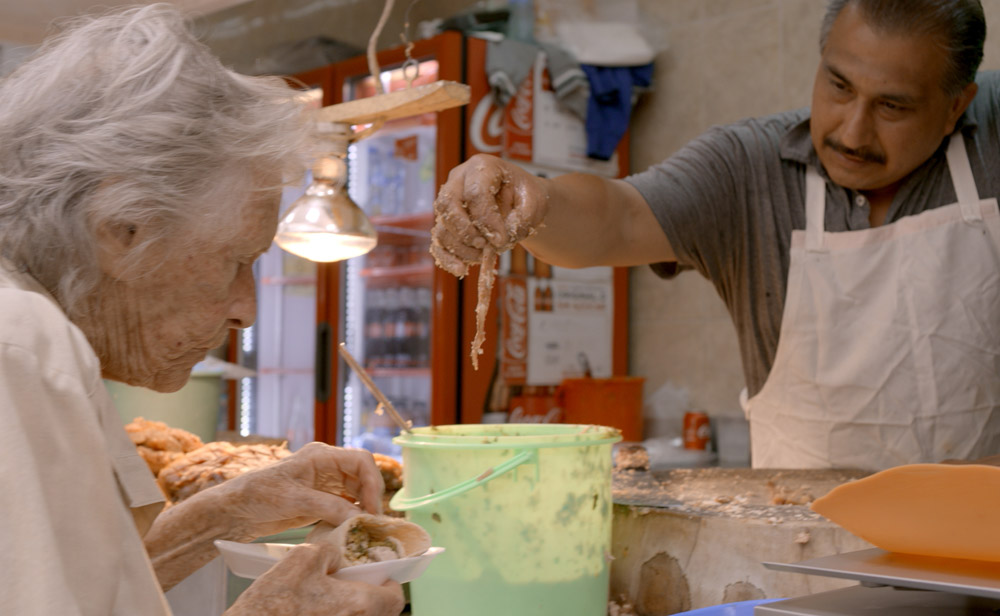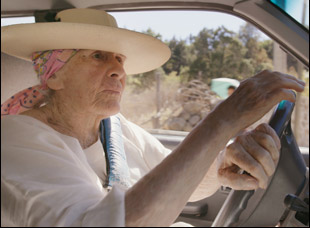Deep in the mountains of Michoacan shrouded in trees, you’ll find Quinta Diana, the self-sustaining ecological home of the chef and cookbook author Diana Kennedy. Electricity may have trouble getting to these parts, but it’s never in short supply with the 95-year-old who always seems to be on the move, whether it’s for a morning walk where she’ll gladly tell barking dogs along the way to shut up to keep the peace or drive out to the city to taste a new variation on mole, honking at other cars to clear the road. She’s a force of nature that director Elizabeth Carroll at once found incredibly difficult to capture in her wildly entertaining portrait “Diana Kennedy: Nothing Fancy,” and remarkably accessible, having commandeered an invitation to be interviewed for a film about how traditions are passed down in Mexican cooking and naturally assumed it would be entirely about her, not only owing to her self-confidence but well aware that she had quite a life story to tell.
It was all too perfect that Carroll became an unexpected messenger for Kennedy’s tale when the no-nonsense chef herself was such an unlikely conduit to raise the profile of Mexican cooking around the world, first learning to cook while being part of the women’s timber corp in England during World War II and relearning it after meeting her husband Paul Kennedy, a New York Times correspondent based in Mexico and bringing back her rigorously researched recipes to the English-speaking world. Fiercely protective of the culture she had fallen in love with, she wasn’t anticipating a career built on her knowledge of Mexican cuisine until Paul’s New York Times colleague Craig Claiborne commissioned a shoot at her apartment preparing Papadzules, leading to teaching cooking classes and eventually, as the likes of Alice Waters, Gabriela Camara and Jose Andres attest in “Nothing Fancy,” a crucial role in popularizing and building a respect for the great culinary traditions of her adopted home country.
Although the legacy Kennedy has created cannot be torn down, Carroll catches the nonagenarian pondering what will happen to Quinta Diana after she leaves this realm, a testament to the self-reliance and partnership with the environment that she holds so dear yet offers no obvious heirs to leave it to, and “Nothing Fancy” evolves from a celebration of its spirited star to a soulful consideration of how Kennedy is faced with letting go of the kinds of things that she spent her life saving for previous generations to keep their heritage alive and vital. It’s an enormously engaging film that took SXSW by storm a year ago, winning a Special Jury Prize for Carroll for Excellence in Storytelling and with the film now making its way on demand, the filmmaker spoke about how the story found her in a sense, finding the rose amidst the thorns with such a wonderfully prickly subject such as Kennedy, and how all the bumps along the way to her first feature only went to producing a more resplendent gem.
I was living in Austin and working at a coffee shop at the end of 2013 and I wanted to interview a bunch of Mexican people in the food world, particularly women, who could talk about passing down recipes and food traditions through a contemporary lens, and I had been doing a ton of research on food for years and I felt pretty strong in my understanding of famous chefs throughout certain decades, but I found Diana and I was like, “Whoa, how do I not know about this woman?” I was shocked that I somehow missed her and in retrospect, she seemed to be more of a prominent name during my parents’ generation and if anyone was into cooking, they had heard of her at that time, but a lot of other people just didn’t. So I think, “God, I’ve got to talk to this woman. She’s not Mexican, but obviously she’s an expert on the subject.”
I thought I have to find her somehow, but I had no idea how to go about contacting her, and I left the coffee shop and I was on my way to my restaurant job and I stopped at BookPeople, [where] I would maybe go a couple times a year at that point, so it was just random that I ended up looking through a book about Oaxaca food and 30 minutes later, I pull into the parking lot at BookPeople and look at the marquee and it says “Book Signing with Diana Kennedy tomorrow.” So it was a really bizarre, amazing cosmic whirlwind that started right then and there.
Did you immediately shift your ideas about the film from something more general to a profile of her?
At that point, the film totally changed because the moment that Diana said that she’d be willing to have a feature film made about her, I just threw away the other idea and the film quickly became a character portrait on her. Then it was just about putting the pieces together about her history, where she had gone, who she knew, and I wasn’t even really able to scratch the surface from whom she had gotten a lot of her information because they were all dead mostly — families she had spoken to in the late ‘50s, early ‘60s. It was just so fascinating because that was a completely different time and the access we had was her sitting at the table and talking about an experience and getting kind of wistful or [you could see it] in her eyes. It was amazing driving down to Oaxaca with her and just seeing how she reacted and was interacting with that environment.
And originally, I wanted to make a verite film about Diana [because] the Maysles Brothers had a big impact on me when I was learning about documentary, so it was like what if this was “Grey Gardens,” but “Jiro Dreams of Sushi,” set in Mexico? Initially, I was so much a fan of the idea of just letting a subject speak for his or herself, but then realizing this is probably the only film that’s going to be made about Diana and she has a very rich and specific history and a very specific impact on Mexico and on the food world, it became pretty clear to me that I had a responsibility to clarify that her contextual place in space and time, so I’m glad that I didn’t go with my more avant grade sensibilities. So by the end, my hope was to create a balance between that original falling in love with the idea of just letting her speak for herself and letting the viewer intuit what was going on versus layering her history and her context in a more archival traditional way and then having a couple interviews, but not too many.
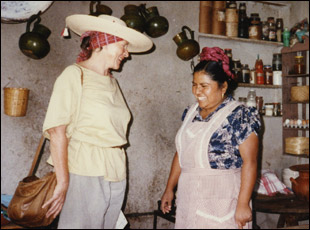
Yeah, at first one might look at it, and I certainly did, as a pitfall. I was like, “This is almost embarrassing how long it’s taking me to get this film funded and finished,” but at the same time, it’s just the nature of documentary and had I gotten all the funding at the beginning, we would’ve been done much earlier, but the length of time that it took was not only critical for the development of my relationship with Diana and the narrative of aging that was essential to what the film ultimately became. And this was my first movie, so for my own journey as a filmmaker, I didn’t really know what I was doing at the beginning and it was really critical for me to have that amount of time to very carefully examine every challenge and go up the mountain. I certainly made mistakes and could’ve done a lot of things differently, but I don’t have any regrets.
One of my favorite sequences in the film is when you see Diana making guacamole at one point and you realize everything that went into perfecting this recipe over the years through cutting back and forth in time. Was it a challenge to get examples like that where you could show influence in a visual way?
Yes, because at a certain point she was, ironically, unwilling to cook on camera. We got all the stuff we got during the food camp scenes with the other chefs there, but she was very protective of that as well, and she [would say], “This isn’t just a free cooking show for people. They have to do the work.” So whatever she was feeling in the moment was what we had to go with, and there would be times where I would make it very clear to her, like, “Diana, it would really mean a lot if you could cook something for us on camera. We need a little bit more of you in the kitchen.” And I think the way she viewed it was these massive productions because she made her TV show in 1992 — she did 27 episodes, which never ended up airing really, which is another sort of mystery of the film — but she got accustomed to this very specific way of cooking on camera, so whenever I would say, “hey, could you make something for us on camera,” she would associate it with that level of [rigorous] production value. I’m very glad she did that.
For the guacamole scene, it worked out perfectly and the idea to splice the scenes didn’t come until we were editing. When we were filming with her making the guacamole in 2015, I hadn’t seen the guacamole episode from her show, so I had no idea that the existing episode from her show matched it so perfectly, so when we were watching it in the edit and we saw that, I was like, “Oh my God, it’s the same scene.” She has not changed her tune at all and I loved that.
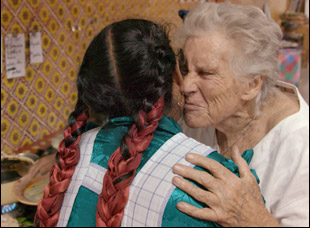
She wouldn’t let me touch a lot of her archive, which is interesting because she was letting me into her world and letting me do this film, but she was very protective of the actual archive. That was understandable because at this point, they’re pretty precious. But in order to properly scan things, I would have to take them back to New York with me from her house or go to Mexico City with them. We tried to bring a scanner down to her house and her electrical system just didn’t work — we couldn’t plug it in and it was kind of a disaster.
Thankfully, I was able to get the VHS tapes eventually from her and that had all the shows on it and a few other things, and we were able to get anything we wanted in her house. We finished filming before she had given all her stuff to UTSA, so she was still deciding where her archive was going to live at that point. All of her papers stacked around the house and she was getting ready to transfer them, so it was always a combination of assertively saying, “Diana, we need to get this. Can you let us do this?” and then bending to her will of just what she was comfortable letting us touch.
It really navigates her history well and there’s this layering that happens stylistically. Was it a challenge to structure?
It was interesting because we ended up having two different versions of the film, so the one you originally saw [at SXSW] was a little bit shorter version, and they’re a little bit the same — there was like one scene taken out and a couple of scenes added to the final version. We were very pressed for time in our final edits, as everyone is, and it was ultimately like a hail mary how the South By cut worked out. I was amazed at the reception and [then] it was like, “Oh, shit. This is not going to be as good…” [when] I didn’t think I’d have enough time to perfect everything about it, but I was really happy with the rhythm of the layering [of the present building upon the past]. Ultimately, that is so essential because you’ve got to keep the story moving. You can’t let the water jag me around and even if you’re having a pensive moment, there’s still tension and rhythm to that, and I always personally enjoy when a filmmaker would play with my sense of time, not to scramble or confuse me, but to give a sense that this is what happened back here and throughout the film, you’re constructing your own puzzle of the narrative and learning more about this person so it makes sense why they are the way they are this way [now].
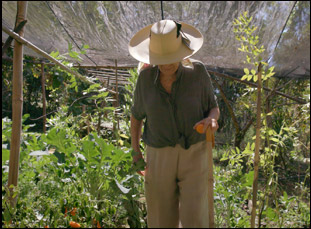
It was like the greatest feeling. Like I said, post-production was incredibly stressful and I was not prepared for that. We’d been clipping along and getting closer and it’s like, “Okay, we know we’re going into this tunnel and when we come out of the tunnel, we’re going to have a finished movie, but we don’t know what’s going to happen in the darkness of this very scary tunnel. We had a rough cut when we were accepted to South By, so we had six weeks to finish the film and there was a lot of stuff that happened that made it very difficult and when we were able to work full-time on it, we had about 10 days to finish and send it to post and then turn around and went directly to Austin. [That time] was a complete blur.
But getting back to Austin where I’m from and my family showing up, I remember my dad looked so confused at our premiere because he was always like, “Yeah, but are you going to make any money off this?” And I’m like, “Dad, just stick with me here,” and when we got to South By, he’s like, “Wait a minute, this thing that you’ve been telling me about for six years that I honestly thought was bullshit, like wow, you really did it. So impressive.” So it was really stressful, but then really fun. Once we finished and we won the Jury Award, [we were accepted into] a bunch of other festivals and then the whole year was this travel whirlwind — the opposite of 2020 now we’ve been on lockdown, but I didn’t stop moving in 2019 and it was the wildest, most fun, exciting year of my life.
“Diana Kennedy: Nothing Fancy” will be available on iTunes on June 19th.




